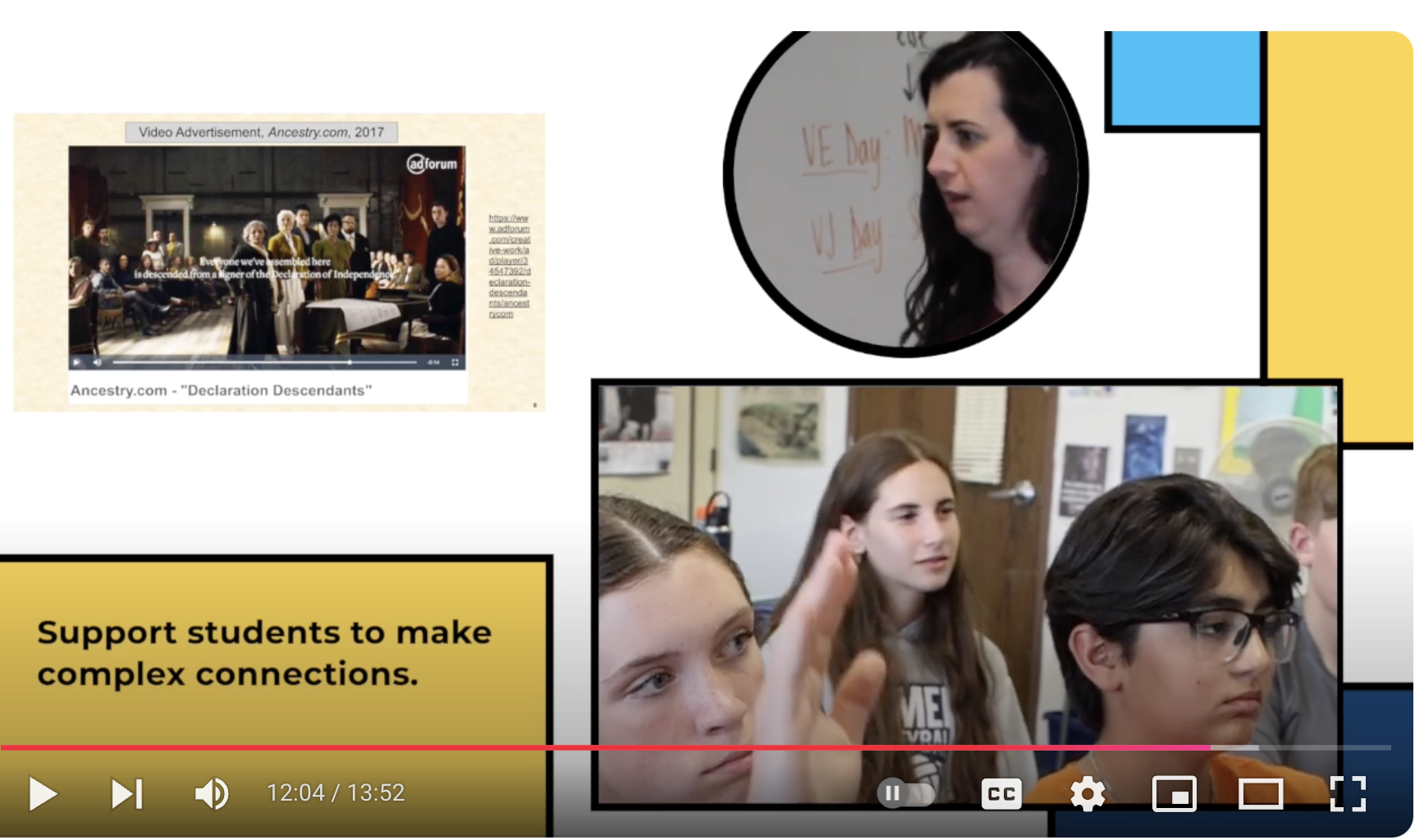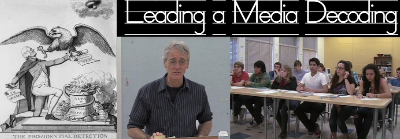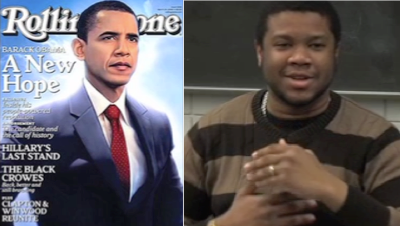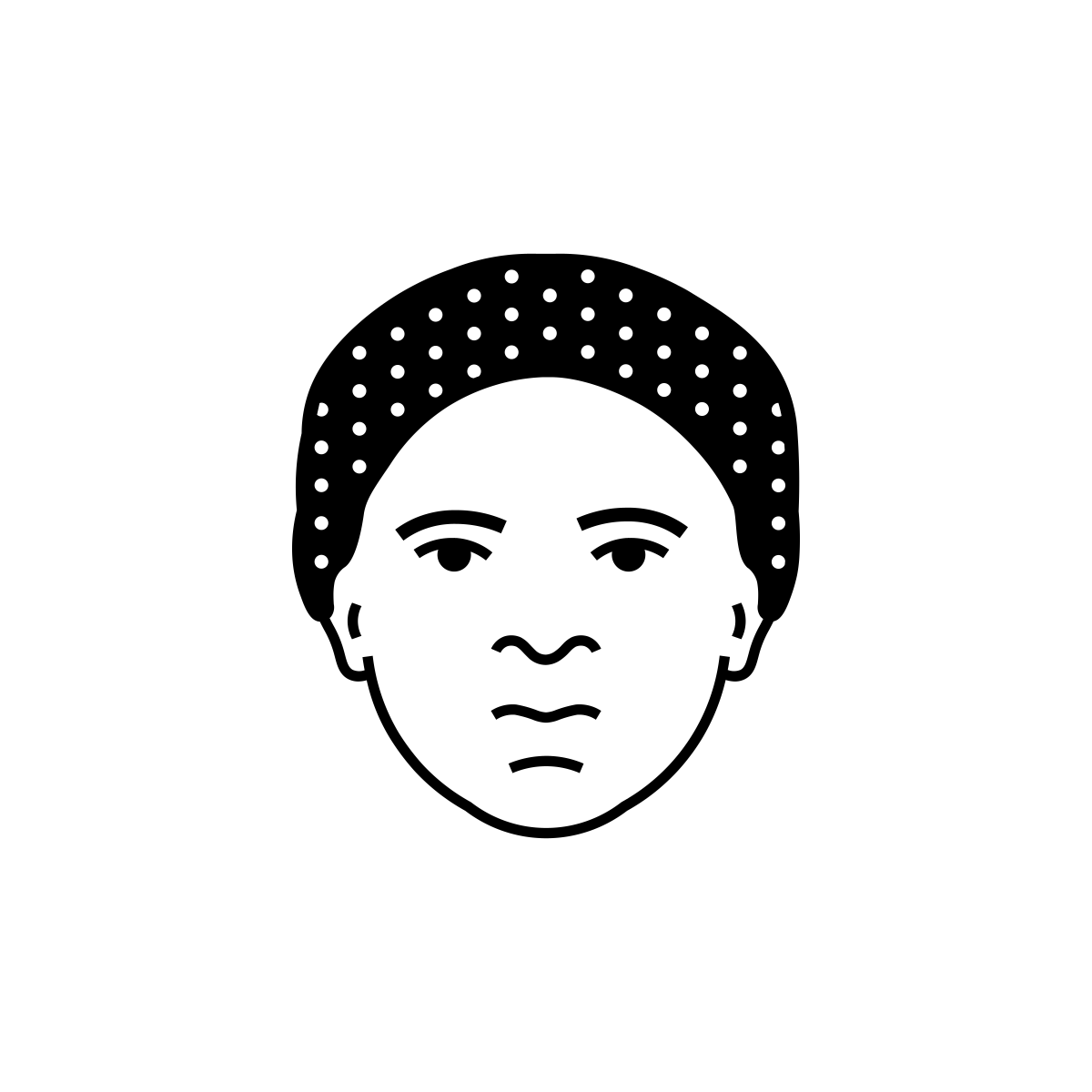Your Search Results (1006) sorted by newest
Bias in Charts: Temperature and Climate Change
Students analyze a chart from NASA and a tweet from the National Review for messages about climate change and bias in media construction of charts.
15-30 Minutes
Cinematic Stereotyping - High School Teachers in the Movies
Students analyze a Google search and clips from feature films for messages about stereotypes of teachers, about the impact of film representations of teaching and about the pedagogical process of question-based, student-centered constructivist media decoding.
30-60 Minutes
Clickbaiting Our Emotions: AI Deepfakes
Students analyze a social media post and a TV news report for messages about A.I. deepfakes and assessing credibility of media messages.
15-30 Minutes
Confronting Personal Challenges - Bethany Hamilton in Film
Students analyze trailers from documentary and feature films for messages about film genres and techniques, about interpretation of media messages and about how people persevere through personal challenges.
15-30 Minutes
College or a Trade: Which is the Right Choice?
Students analyze two posters for messages about the potential benefits and challenges of college or trade career choices.
15-30 Minutes
Cinematic Stereotyping - Elementary School Teachers in the Movies
Students analyze a Google search and clips from feature films for messages about stereotypes of teachers, about the impact of film representations of teaching and about the pedagogical process of question-based, student-centered constructivist media decoding.
30-60 Minutes
Cinematic Stereotyping - Librarians in the Movies
Students analyze a Google search and film clips for messages about libraries and librarians and about purpose and effects of media messages.
15-30 Minutes
Librarians in the Movies - Media Messages and Effects
Students analyze film clips for messages about libraries and librarians and about purpose and effects of media messages.
15-30 Minutes
Houses Around the Globe: Decoding Book Covers
Students analyze book covers for messages about houses and homes around the world, how different book covers treat similar topics, and choosing books to read.
15-30 Minutes
Social Media & Trigonometry: What's the Best Explanation?
Students analyze a YouTube video, an Instagram post and a TikTok video for messages about trigonometric functions and about the effectiveness of social media videos to learn and teach math.
15-30 Minutes
Way to Go! Decoding Media about Transportation
Students analyze an ebook, an animated video and a ”Kids News” video for messages about transportation choices, environmental impact, media forms and target audience.
30-60 Minutes
Bias in Charts: Race, Gender, Education, and Income
Students analyze charts from the New York Times and a blog post for messages about income related to race and gender and about credibility and bias in media construction of charts.
30-60 Minutes
Paul Revere's Midnight Ride
Students analyze Paul Revere’s account of his midnight ride, Longfellow’s poem and a YouTube video to consider context and sourcing in recounting an historic event.
30-60 Minutes
The Boston Massacre: A Bloody Slaughter or Self Defense?
Students analyze Paul Revere’s engraving of the Boston Massacre, a newspaper account by the imprisoned British commander, a sworn deposition by an eyewitness, and the court testimony of another eyewitness to learn about sourcing, bias, and credibility in historical sources.
30-60 Minutes
Lewis Hine and Child Labor: Photography of Persuasion
Students will analyze and ask questions about photographs to learn about persuasive techniques, intent, impact, and to reflect on historical context and perspective.
30-60 Minutes
What is Democracy?
Students analyze short videos for messages about different forms of democratic process in the U.S., personal bias and video techniques.
30-60 Minutes
Demonstration Video: January 6, 2021: Newspaper Front Pages
Middle School teacher, Mary Kate Longeran, leads her students through a decoding of domestic and international newspapers - using the Project Look Sharp lesson: “Storming the Capital” - to analyze media construction and bias in news coverage. (Total Time: 8:57) Published 2023
View
Constructivist Media Decoding
Media Literacy Lesson Design
Reflecting Diversity
Social Studies
English Language Arts
Health
Pre-service Teacher Education
Graphing the Vote: Age, Gender, and Time
Students will tell the stories behind political graphs by: analyzing graphs about generational voting, asking questions about the sourcing and target audience, and reflecting on patterns in youth voting. This lesson has the potential to promote polarization. See the advice in the lesson plan.
30-60 Minutes
Interview: "Media Literacy and Me" Radio Kerry June 28th, 2024
Jerry O'Sullivan, host of the current affairs radio show Kerry Today in Ireland, interviews Executive Director Cyndy Scheibe to discuss the need for media literacy in public schools (in Ireland and in the U.S.), and the role that Project Look Sharp's resources can play in supporting Irish teachers and students.
Download
Constructivist Media Decoding
Media Literacy Lesson Design
Critical Thinking And The News
Assessing Credibility & Bias
Civics
Chris Sperry, Prescription for an Infodemic, a pedagogical response in an era of fake news, In Victor Strasberger (Ed.), kids and today’s Media: A careful analysis and scrutiny of the problems, volume 2, New York: Rowman and Littlefield, 2021.
In this chapter from the 2021 book, Kids and Today’s Media, Chris Sperry lays out Project Look Sharp’s approach to disinformation. After a look at the historical context of our country’s “epistemological crisis” and the role of confirmation bias, Chris makes the case for media literacy and specifically Constructivist Media.
Download
Constructivist Media Decoding
Media Literacy Lesson Design
Critical Thinking And The News
Assessing Credibility & Bias
Social Studies
English Language Arts
Health
Pre-service Teacher Education
Civics
Declaration of Independence: Sourcing, Credibility, & Bias
Middle School teacher, Mary Kate Lonergan, leads her students through a decoding of domestic and international newspapers - using the Project Look Sharp lesson: “Storming the Capital” - to analyze media construction and bias in news coverage. (Total Time: 8:57) Published 2023
View
Constructivist Media Decoding
Assessing Credibility & Bias
Social Studies
Pre-service Teacher Education
Civics
The Immigration Debate: Trump vs Harris
Students analyze political ads from the 2024 presidential campaign for messages about immigration, media construction, and our own interpretations.
15-30 Minutes
What is a Campaign?
Students analyze historic and contemporary campaign media for messages about purpose, media types and democratic process.
30-60 Minutes
Satirizing Trump and Harris - Comedy, Bias, and Impact
Students explore political satire through the analysis of comedy sketches related to the 2024 presidential debate between Kamala Harris and Donald Trump.
15-30 Minutes
Messaging Masculinity in the 2024 Presidential Campaign
Students analyze speeches and analysis from the 2024 Republican and Democratic conventions for messages about defining masculinity, political campaign messaging and identity as a factor in media interpretation.
30-60 Minutes
Harris vs Trump: Whose Language, Whose Issues?
Students analyze webpage issue lists to identify which are from the Harris and which are from the Trump campaigns, reflecting on language choices, target audience, and their own biases.
15-30 Minutes
An Aesop Fable: Media, Morals, and More
Students compare an audio recording, video, and text of the Aesop story, the Tortoise and the Hare, to understand fables and compare different media forms.
30-60 Minutes
Tracking Climate Urgency: 30 years of IPCC Reports
Students analyze short quotes from Intergovernmental Panel on Climate Change reports from 1990-2020 for messages about scientific conclusions and persuasive language related to the climate crisis.
15-30 Minutes
Kamala Harris & Donald Trump Video Biographies
Students analyze Donald Trump and Kamala Harris film biographies for messages about presidential leadership, media creation, and how political bias shapes media interpretation.
15-30 Minutes
Video Games & Climate: Analyzing Constructions of the Future
Students analyze video game trailers for messages about climate change and possible futures, about storytelling and marketing techniques and about whether video games can impact social change.
30-60 Minutes
Media Construction of Presidential Campaigns
Related to kit: Media Constructions of Presidential Campaigns
A study of select campaign posters, cartoons, and ads teaches students to critically analyze messages from media source and to understand the role media have played throughout the history of American elections. By Chris Sperry and Sox Sperry, Social Education, November/December 2007.
Download
Critical Thinking And The News
Lesson Conception
Social Studies
Media Constructions of Presidential Campaigns
Related to kit: Media Constructions of Presidential Campaigns
The webinar offers high school educators and teachers-in-training pedagogical techniques and free curriculum materials to support a deeper understanding of how to use a wide variety of media forms across the historical spectrum - media from 19th century portraits, songs and handbills, to 21st century websites, twitter and email - to study historical context and to question their credibility.
View
Constructivist Media Decoding
Media Literacy Lesson Design
Youth Culture And New Technologies
Assessing Credibility & Bias
Do No Harm
Document Selection
Lesson Conception
Social Studies
High School US History: 1800 Anti-Jefferson Political Cartoon
Related to kit: Media Constructions of Presidential Campaigns
An example of leading a class through a constructivist media decoding using a lesson from our kit, Media Construction of Presidential Campaigns. Students in this video decode political cartoons against Thomas Jefferson.
View
Constructivist Media Decoding
Social Studies
College Level: 2008 Election Magazine Covers
Related to kit: Media Constructions of Presidential Campaigns
An example of leading a class through a constructivist media decoding using a lesson from our kit, Media Construction of Presidential Campaigns. Students in this video decode various magazine covers portraying Barack Obama during the 2008 election.
View
Constructivist Media Decoding
Critical Thinking And The News
Social Studies
English Language Arts
(Not So) Unprecedented Media Analysis of the 2016 Presidential Race and Its Historical Precedents
This article helps teachers to understand how to use media documents from the 2016 presidential race (as well as past campaigns) to critically analyze media messages to teach objectives from the new NCSS C3 Framework for the Social Studies and the Common Core ELA standards for secondary social studies. When students examine election posters, cartoons, and ads they will comprehend that many themes--including xenophobia, income inequality, and women's political power--have been historical mainstays on the campaign trail.
Download
Critical Thinking And The News
Social Studies
Climate Change Through Time Magazine Covers
Students analyze Time magazine covers from 1970-2022 for messages about how climate change has been represented in a mainstream magazine and the choices magazine designers make in selling their products.
15-30 Minutes
How Big is the Crowd? Proportional Reasoning and Critical Thinking
Students use mathematical reasoning to evaluate claims about crowd size for President Trump’s 2016 inauguration, and reflect on confirmation bias when assessing truth claims in the media.
30-60 Minutes
Climate Change Through Memes
Students analyze memes for messages about climate change and about how memes as a media form impact social change.
Under 15 Minutes
To Break the Glass Ceiling: Analyzing Campaign Ads by Women Running for President
Students analyze political campaign ads for messages about female presidential candidates, historical and cultural context, and techniques of persuasion.
15-30 Minutes
Good Data - Bad Feelings: Graphing Economics, Public Opinion and Media Coverage
Students analyze graphs and media analysis for messages about the relationship between media reporting on the economy and public opinion.
Over 60 Minutes
Climate Change Through Movie Posters
Students analyze film posters from 2004-2022 for messages about how climate change has been represented in cinema, and the impact of film socially and personally.
15-30 Minutes
Christmas Love - SEL and Media Literacy
This lesson can teach to SEL objectives by having students identify emotions through facial expressions and/or media literacy objectives by having students analyze the messages and techniques used in a commercial.
15-30 Minutes
Christmas Love - Advertising, Emotions, and Literary Elements
Students analyze a short video commercial about “Christmas Love” for its purpose, the elements and techniques of storytelling, and to reflect on the role of emotion and identity in interpretation of media messages.
15-30 Minutes
Music, Media, and Meaning
Students analyze a short clip from the movie Lion King with four different musical accompaniments to recognize how music influences our emotions and communicates different messages.
15-30 Minutes
Media Constructions of the Signing of the Declaration of Independence
Students analyze diverse media forms related to John Trumbull’s famous painting of the signing of the Declaration of Independence for messages about the event, the credibility and qualities of different media forms, and about American history.
30-60 Minutes
Wellness Claims and Social Media
Students analyze social media posts with health/wellness claims and evaluate their credibility.
30-60 Minutes
The History of Cigarette Commercials: Issues of Persuasion and Regulation
Students analyze 3 TV commercials and a PSA for cigarettes from the 1950s-1960s to assess marketing techniques, health messages and gender stereotypes, and then read about and discuss the 1970 congressional ban on cigarette advertising on television.
30-60 Minutes
Deepfakes: What Do We Believe? What Do We Share?
Students evaluate Internet images and videos as fake or true and reflect on how confirmation bias impacts our judgments.
30-60 Minutes
Flags: Geometry, Algebra and Cultural Context
This math and/or social studies lesson has students analyze flags from around the world, to understand aspect ratio, flag design and historical context.
30-60 Minutes
Picturing the Underground Railroad: Historical Context Through Book Covers
Students analyze three book covers to understand historical context, to reflect on how identity impacts interpretation, and to discuss the role of media makers in crafting historical representations.
15-30 Minutes
Fyre Festival: Gender, Wealth and Happiness in Social Media
Students analyze a short video ad and social media posts for messages about gender, wealth and success; to assess the credibility of media messages; and to reflect on the role media play in shaping our views.
15-30 Minutes
Charting Media Coverage of War: Israel/Palestine
Students analyze charts with text excerpts from articles for messages about bias in media coverage of the Israel Hamas war, to analyze the bias in the construction of the charts, and to reflect on their own interpretations.
30-60 Minutes
UN Sustainable Development Goals and Graphics
Students analyze icons for messages about graphic design and the United Nations 17 Sustainable Development Goals.
30-60 Minutes
Comic Superheroes and Historical Context
Students analyze comic book covers for messages about historical context and book cover design techniques.
30-60 Minutes
Hear Our Voices
Media literacy and critical thinking lesson using diverse media imagery to teach about the history of the women's suffrage movement in the United States.
This lesson is part of a "kit" or collection of media decoding lessons on a particular topic. You can explore that kit using the link below:
Unit: Women's SuffrageKit: Media Constructions of Social Justice
30-60 Minutes, Over 60 Minutes
Which Side Are You On?
Media literacy and critical thinking lesson using diverse media imagery to teach about the history of the U.S. labor movement between Reconstruction and World War One.
This lesson is part of a "kit" or collection of media decoding lessons on a particular topic. You can explore that kit using the link below:
Unit: Early Labor MovementKit: Media Constructions of Social Justice
30-60 Minutes, Over 60 Minutes
Challenging White Supremacy
Media literacy and critical thinking lesson using diverse media imagery to teach about the history of the black freedom/civil rights movement in the United States.
This lesson is part of a "kit" or collection of media decoding lessons on a particular topic. You can explore that kit using the link below:
Unit: Black Freedom/Civil RightsKit: Media Constructions of Social Justice
30-60 Minutes, Over 60 Minutes
Claiming Feminist Identities
Media literacy and critical thinking lesson using diverse media imagery to teach about the history of the late 20th century women's liberation movement in the U.S.
This lesson is part of a "kit" or collection of media decoding lessons on a particular topic. You can explore that kit using the link below:
Unit: Women's LiberationKit: Media Constructions of Social Justice
30-60 Minutes, Over 60 Minutes
The Law of Immigration
Media literacy and critical thinking lesson using diverse media imagery to teach about the history of immigration reform debates in the U.S since the early 20th century.
This lesson is part of a "kit" or collection of media decoding lessons on a particular topic. You can explore that kit using the link below:
Unit: Immigrant RightsKit: Media Constructions of Social Justice
30-60 Minutes
Out and Affirmed
Media literacy and critical thinking lesson using diverse media imagery to teach about the history of the gay liberation movement in the U.S.
This lesson is part of a "kit" or collection of media decoding lessons on a particular topic. You can explore that kit using the link below:
Unit: Gay LiberationKit: Media Constructions of Social Justice
30-60 Minutes
Prisons- Justice or Injustice
Media literacy and critical thinking lesson using diverse media imagery to teach about the prison justice movement from the late 20th and early 21st centuries.
This lesson is part of a "kit" or collection of media decoding lessons on a particular topic. You can explore that kit using the link below:
Playlist: Economics & Social JusticeUnit: Prison Justice
Kit: Media Constructions of Social Justice
30-60 Minutes
Questioning Manifest Destiny
Media literacy and critical thinking lesson using diverse media imagery to teach about efforts to oppose manifest destiny during the Indian Wars, Mexican War and Philippine-American War.
This lesson is part of a "kit" or collection of media decoding lessons on a particular topic. You can explore that kit using the link below:
Unit: Wars of Manifest Destiny: Indian, Mexican and Spanish American WarsKit: Media Constructions of Peace
Over 60 Minutes
Peace or Liberty?
Media literacy and critical thinking lesson using diverse media imagery to teach about the history of antiwar movements during World War One.
This lesson is part of a "kit" or collection of media decoding lessons on a particular topic. You can explore that kit using the link below:
Unit: World War OneKit: Media Constructions of Peace
30-60 Minutes
For Peace or Against Oppression?
Media literacy and critical thinking lesson using diverse media imagery to teach about the history of antiwar movements during the World War Two period.
This lesson is part of a "kit" or collection of media decoding lessons on a particular topic. You can explore that kit using the link below:
Unit: World War TwoKit: Media Constructions of Peace
30-60 Minutes
A History of Global Warming in Science, Politics, and the Media
Media literacy and critical thinking unit using diverse media imagery to teach about how global warming has been perceived by people in the U.S. and how the media has constructed that public perception.
This lesson is part of a "kit" or collection of media decoding lessons on a particular topic. You can explore that kit using the link below:
Playlist: Climate Change
30-60 Minutes, Over 60 Minutes
The War in Editorial Cartoons
Media literacy and critical thinking lesson analyzing issues related to the Iraq War by identifying messages and stereotypes in editorial cartoons.
This lesson is part of a "kit" or collection of media decoding lessons on a particular topic. You can explore that kit using the link below:
Unit: War in Iraq: Whose Voice, Whose Story?Kit: Media Constructions of the Middle East
30-60 Minutes
Latin American Immigration in Editorial Cartoons
Media literacy and critical thinking lesson analyzing messages about U.S. immigration in editorial cartoons from 5 Latin American countries.
This lesson is part of a "kit" or collection of media decoding lessons on a particular topic. You can explore that kit using the link below:
Kit: Global Media Perspectives
30-60 Minutes, Over 60 Minutes
The Intolerable Acts
Media literacy and critical thinking lesson about political cartoons and the Intolerable Acts.
This lesson is part of a "kit" or collection of media decoding lessons on a particular topic. You can explore that kit using the link below:
Kit: Causes of the American Revolution
15-30 Minutes
History of Chemicals in the Environment
Media literacy and critical thinking unit using diverse media imagery to teach about how chemicals in the environment have been perceived by people in the U.S. and how the media has constructed that public perception. Focus topics include pesticides, fertilizer, gasoline additives and persistent organic pollutants.
This lesson is part of a "kit" or collection of media decoding lessons on a particular topic. You can explore that kit using the link below:
Kit: Media Constructions of the Environment: Chemicals in the Environment
30-60 Minutes, Over 60 Minutes
History of Endangered Species
Media literacy and critical thinking unit using diverse media imagery to teach about how endangered species have been perceived by people in the U.S. and how the media has constructed that public perception. Focus topics include indigenous perspectives, whaling, habitat destruction and the Endangered Species Act.
This lesson is part of a "kit" or collection of media decoding lessons on a particular topic. You can explore that kit using the link below:
Kit: Media Constructions of the Environment: Endangered Species
30-60 Minutes, Over 60 Minutes
Poverty: Climate Change & Water Security
Media literacy and critical thinking activity in which students decode web pages for messages about the conditions that make people living in poverty extremely vulnerable to the impacts of climate change.
This lesson is part of a "kit" or collection of media decoding lessons on a particular topic. You can explore that kit using the link below:
Playlist: Economics & Social JusticeUnit: Climate Change & Water
Kit: Media Constructions of Sustainability: Middle School
15-30 Minutes
What's So Funny about Climate Change? Editorial Cartoon Opinions
This is a media literacy and critical thinking activity in which students analyze six editorial cartoons for conflicting perspectives on the direness of the threat of climate change.
This lesson is part of a "kit" or collection of media decoding lessons on a particular topic. You can explore that kit using the link below:
Playlist: Climate Change
30-60 Minutes
Carbon Trading: Arguments for and Against
This is a media literacy and critical thinking activity in which students analyze a webpage from the World Economic Forum and an online comic book for conflicting perspectives on the impacts of carbon trading.
30-60 Minutes
Anti-Semitism: Then and Now
This is a media literacy and critical thinking activity in which students analyze a poster, a tweet and an editorial cartoon for messages about anti-Semitism.
15-30 Minutes
Decoding the Twenty: Andrew Jackson and Harriet Tubman
In this media literacy activity students analyze images related to the twenty dollar bill for messages about U.S. history and historical context.
15-30 Minutes
Wash Your Hands – What’s the Right Way?
In this media literacy activity students analyze a comic, a graphic, a music video and a public service announcement for messages about the best way to wash your hands to protect yourself from getting sick.
15-30 Minutes
How Disease Spreads: Cholera Epidemic of 1892
In this media literacy activity students analyze an anti-Semitic editorial cartoon and newspaper editorial from the 1890s, an excerpt from a contemporary magazine article and a webpage from a respected medical health center for messages about the social and scientific beliefs that inform our knowledge about how cholera spreads.
30-60 Minutes
COVID-19 and the Economy: Conflicting Priorities
In this media literacy activity students analyze two opinion pieces for messages about how to manage the economy during a global health crisis.
30-60 Minutes
Female Superheroes: Changing Powers Over Time
In this media literacy activity students analyze female superheroes from comics of the 1960s and 2010s for messages about changes in media representations of gender and power across fifty years.
15-30 Minutes
Dolphins in the Media
Students analyze a book cover, a magazine cover, a tweet, a poster, a cartoon, a toy and an advertisement for messages about media forms, dolphins and environmental concerns.
15-30 Minutes
The Early Feminists and Haudenosaunee Women: The Origins of Women’s Rights in the U.S.
Students analyze and ask questions about a 1914 political cartoon and a 2020 documentary film clip for messages about the impact of Haudenosaunee women on the early women’s rights movement in the United States.
15-30 Minutes
Kerblam!*! - Violence in Comics
Students analyze comic book covers for messages about violence and about the differences between realistic fiction and fantasy.
15-30 Minutes
Exploring Genres Through Book Covers - Upper Elementary
Students analyze book covers for messages about literary genres and compare texts in different genres in terms of their approach to similar topics.
15-30 Minutes
Animals and Images: What do you See?
Students analyze different types of images for messages about image forms and about reptiles, amphibians and dinosaurs.
Under 15 Minutes
GMO Yes or No - Decoding Movie Trailers
Students analyze two short movie trailers for messages about GMOs, to ask and answer questions about sourcing and credibility, and to reflect on their own confirmation biases.
Under 15 Minutes
Pride Month: Representation and Authorship
Students analyze short Pride Month videos for messages about LGBTQ history and culture and its representation.
30-60 Minutes
Exploring Genres Through Book Covers - Lower Elementary
Students analyze book covers for messages about literary genres.
15-30 Minutes
Bias in School Curriculum: News Report or Analysis?
Students analyze a news report and news analysis about bias in school curriculum and about how their own biases influence their interpretations and responses.
15-30 Minutes
Vaccine Safety - Exploring Our Own Biases
Students analyze two short news videos about the safety and speed of the creation of the mRNA Covid vaccine, about sourcing and credibility of the videos and the scientific information presented in them, and about their own confirmation biases.
15-30 Minutes
Winter Holidays Around the World
Students analyze book covers for messages about winter holidays around the world and about book covers as media messages.
15-30 Minutes
The Murders of Osage Indians: Media Forms, Qualities, and Credibility
Students will explore how different media forms represent the history of the Osage murders, the credibility of sources, and their own preferences.
30-60 Minutes
Physics or Fiction - Will Tango and Cash get electrocuted?
After viewing clips from a feature film and web videos, students will identify messages about electrical currents and shock, analyze sources and credibility, and reflect on strategies for finding accurate information.
Under 15 Minutes
Where's the Media? How Can You Tell?
Students analyze an array of images of potential new and old media forms for messages about what constitutes media and the purposes of media through the ages.
30-60 Minutes
Is This Media? How Can You Tell?
Students analyze an array of images for messages about what is media.
Under 15 Minutes
Asian American and Pacific Islander History and Culture: Representation and Authorship
Students analyze short videos for messages about Asian American and Pacific Islander histories and cultures and their representation.
30-60 Minutes
A.I. – Pros, Cons, Credibility and Bias
Students analyze short videos for messages about the pros and cons of artificial intelligence, the bias and credibility of each source, and our own thinking about the issue.
30-60 Minutes
Starter Kit for Elementary Library & Information Literacy K-2
This guide gives users a brief overview of our approach (question-based media decoding) and materials (e.g., lessons) available for free from the Project Look Sharp website for a particular level and subject.
View
Constructivist Media Decoding
Media Literacy Lesson Design
Document Selection
Question Design
Starter Kit for Elementary Library & Information Literacy 3-5
This guide gives users a brief overview of our approach (question-based media decoding) and materials (e.g., lessons) available for free from the Project Look Sharp website for a particular level and subject.
View
Constructivist Media Decoding
Media Literacy Lesson Design
Document Selection
Question Design
Starter Kit for Library & Information Literacy 6-8
This guide gives users a brief overview of our approach (question-based media decoding) and materials (e.g., lessons) available for free from the Project Look Sharp website for a particular level and subject.
View
Constructivist Media Decoding
Media Literacy Lesson Design
Document Selection
Question Design
Starter Kit for Library & Information Literacy 9-12
This guide gives users a brief overview of our approach (question-based media decoding) and materials (e.g., lessons) available for free from the Project Look Sharp website for a particular level and subject.
View
Constructivist Media Decoding
Media Literacy Lesson Design
Document Selection
Question Design







.png)






.png)


.png)


































.png)























.png)



















.png)

